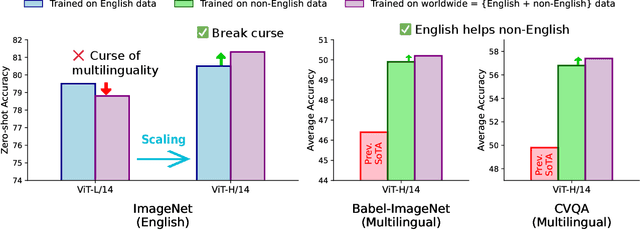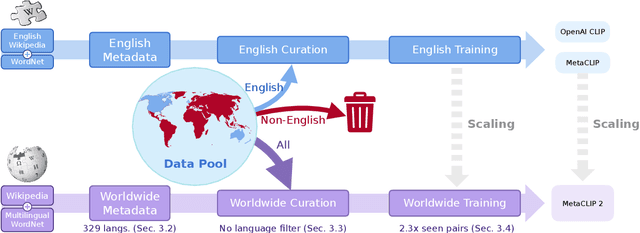Xinlei Chen
Enabling High-Frequency Cross-Modality Visual Positioning Service for Accurate Drone Landing
Oct 01, 2025Abstract:After years of growth, drone-based delivery is transforming logistics. At its core, real-time 6-DoF drone pose tracking enables precise flight control and accurate drone landing. With the widespread availability of urban 3D maps, the Visual Positioning Service (VPS), a mobile pose estimation system, has been adapted to enhance drone pose tracking during the landing phase, as conventional systems like GPS are unreliable in urban environments due to signal attenuation and multi-path propagation. However, deploying the current VPS on drones faces limitations in both estimation accuracy and efficiency. In this work, we redesign drone-oriented VPS with the event camera and introduce EV-Pose to enable accurate, high-frequency 6-DoF pose tracking for accurate drone landing. EV-Pose introduces a spatio-temporal feature-instructed pose estimation module that extracts a temporal distance field to enable 3D point map matching for pose estimation; and a motion-aware hierarchical fusion and optimization scheme to enhance the above estimation in accuracy and efficiency, by utilizing drone motion in the \textit{early stage} of event filtering and the \textit{later stage} of pose optimization. Evaluation shows that EV-Pose achieves a rotation accuracy of 1.34$\degree$ and a translation accuracy of 6.9$mm$ with a tracking latency of 10.08$ms$, outperforming baselines by $>$50\%, \tmcrevise{thus enabling accurate drone landings.} Demo: https://ev-pose.github.io/
COMPASS: Confined-space Manipulation Planning with Active Sensing Strategy
Sep 18, 2025Abstract:Manipulation in confined and cluttered environments remains a significant challenge due to partial observability and complex configuration spaces. Effective manipulation in such environments requires an intelligent exploration strategy to safely understand the scene and search the target. In this paper, we propose COMPASS, a multi-stage exploration and manipulation framework featuring a manipulation-aware sampling-based planner. First, we reduce collision risks with a near-field awareness scan to build a local collision map. Additionally, we employ a multi-objective utility function to find viewpoints that are both informative and conducive to subsequent manipulation. Moreover, we perform a constrained manipulation optimization strategy to generate manipulation poses that respect obstacle constraints. To systematically evaluate method's performance under these difficulties, we propose a benchmark of confined-space exploration and manipulation containing four level challenging scenarios. Compared to exploration methods designed for other robots and only considering information gain, our framework increases manipulation success rate by 24.25% in simulations. Real-world experiments demonstrate our method's capability for active sensing and manipulation in confined environments.
MetaCLIP 2: A Worldwide Scaling Recipe
Jul 29, 2025



Abstract:Contrastive Language-Image Pretraining (CLIP) is a popular foundation model, supporting from zero-shot classification, retrieval to encoders for multimodal large language models (MLLMs). Although CLIP is successfully trained on billion-scale image-text pairs from the English world, scaling CLIP's training further to learning from the worldwide web data is still challenging: (1) no curation method is available to handle data points from non-English world; (2) the English performance from existing multilingual CLIP is worse than its English-only counterpart, i.e., "curse of multilinguality" that is common in LLMs. Here, we present MetaCLIP 2, the first recipe training CLIP from scratch on worldwide web-scale image-text pairs. To generalize our findings, we conduct rigorous ablations with minimal changes that are necessary to address the above challenges and present a recipe enabling mutual benefits from English and non-English world data. In zero-shot ImageNet classification, MetaCLIP 2 ViT-H/14 surpasses its English-only counterpart by 0.8% and mSigLIP by 0.7%, and surprisingly sets new state-of-the-art without system-level confounding factors (e.g., translation, bespoke architecture changes) on multilingual benchmarks, such as CVQA with 57.4%, Babel-ImageNet with 50.2% and XM3600 with 64.3% on image-to-text retrieval.
Context-Aware Sentiment Forecasting via LLM-based Multi-Perspective Role-Playing Agents
May 30, 2025Abstract:User sentiment on social media reveals the underlying social trends, crises, and needs. Researchers have analyzed users' past messages to trace the evolution of sentiments and reconstruct sentiment dynamics. However, predicting the imminent sentiment of an ongoing event is rarely studied. In this paper, we address the problem of \textbf{sentiment forecasting} on social media to predict the user's future sentiment in response to the development of the event. We extract sentiment-related features to enhance the modeling skill and propose a multi-perspective role-playing framework to simulate the process of human response. Our preliminary results show significant improvement in sentiment forecasting on both microscopic and macroscopic levels.
KEVER^2: Knowledge-Enhanced Visual Emotion Reasoning and Retrieval
May 30, 2025Abstract:Understanding what emotions images evoke in their viewers is a foundational goal in human-centric visual computing. While recent advances in vision-language models (VLMs) have shown promise for visual emotion analysis (VEA), several key challenges remain unresolved. Emotional cues in images are often abstract, overlapping, and entangled, making them difficult to model and interpret. Moreover, VLMs struggle to align these complex visual patterns with emotional semantics due to limited supervision and sparse emotional grounding. Finally, existing approaches lack structured affective knowledge to resolve ambiguity and ensure consistent emotional reasoning across diverse visual domains. To address these limitations, we propose \textbf{K-EVER\textsuperscript{2}}, a knowledge-enhanced framework for emotion reasoning and retrieval. Our approach introduces a semantically structured formulation of visual emotion cues and integrates external affective knowledge through multimodal alignment. Without relying on handcrafted labels or direct emotion supervision, K-EVER\textsuperscript{2} achieves robust and interpretable emotion predictions across heterogeneous image types. We validate our framework on three representative benchmarks, Emotion6, EmoSet, and M-Disaster, covering social media imagery, human-centric scenes, and disaster contexts. K-EVER\textsuperscript{2} consistently outperforms strong CNN and VLM baselines, achieving up to a \textbf{19\% accuracy gain} for specific emotions and a \textbf{12.3\% average accuracy gain} across all emotion categories. Our results demonstrate a scalable and generalizable solution for advancing emotional understanding of visual content.
Balanced Token Pruning: Accelerating Vision Language Models Beyond Local Optimization
May 28, 2025Abstract:Large Vision-Language Models (LVLMs) have shown impressive performance across multi-modal tasks by encoding images into thousands of tokens. However, the large number of image tokens results in significant computational overhead, and the use of dynamic high-resolution inputs further increases this burden. Previous approaches have attempted to reduce the number of image tokens through token pruning, typically by selecting tokens based on attention scores or image token diversity. Through empirical studies, we observe that existing methods often overlook the joint impact of pruning on both the current layer's output (local) and the outputs of subsequent layers (global), leading to suboptimal pruning decisions. To address this challenge, we propose Balanced Token Pruning (BTP), a plug-and-play method for pruning vision tokens. Specifically, our method utilizes a small calibration set to divide the pruning process into multiple stages. In the early stages, our method emphasizes the impact of pruning on subsequent layers, whereas in the deeper stages, the focus shifts toward preserving the consistency of local outputs. Extensive experiments across various LVLMs demonstrate the broad effectiveness of our approach on multiple benchmarks. Our method achieves a 78% compression rate while preserving 96.7% of the original models' performance on average.
What Can RL Bring to VLA Generalization? An Empirical Study
May 26, 2025Abstract:Large Vision-Language Action (VLA) models have shown significant potential for embodied AI. However, their predominant training via supervised fine-tuning (SFT) limits generalization due to susceptibility to compounding errors under distribution shifts. Reinforcement learning (RL) offers a path to overcome these limitations by optimizing for task objectives via trial-and-error, yet a systematic understanding of its specific generalization benefits for VLAs compared to SFT is lacking. To address this, our study introduces a comprehensive benchmark for evaluating VLA generalization and systematically investigates the impact of RL fine-tuning across diverse visual, semantic, and execution dimensions. Our extensive experiments reveal that RL fine-tuning, particularly with PPO, significantly enhances generalization in semantic understanding and execution robustness over SFT, while maintaining comparable visual robustness. We identify PPO as a more effective RL algorithm for VLAs than LLM-derived methods like DPO and GRPO. We also develop a simple recipe for efficient PPO training on VLAs, and demonstrate its practical utility for improving VLA generalization. The project page is at https://rlvla.github.io
DIMM: Decoupled Multi-hierarchy Kalman Filter for 3D Object Tracking
May 18, 2025Abstract:State estimation is challenging for 3D object tracking with high maneuverability, as the target's state transition function changes rapidly, irregularly, and is unknown to the estimator. Existing work based on interacting multiple model (IMM) achieves more accurate estimation than single-filter approaches through model combination, aligning appropriate models for different motion modes of the target object over time. However, two limitations of conventional IMM remain unsolved. First, the solution space of the model combination is constrained as the target's diverse kinematic properties in different directions are ignored. Second, the model combination weights calculated by the observation likelihood are not accurate enough due to the measurement uncertainty. In this paper, we propose a novel framework, DIMM, to effectively combine estimates from different motion models in each direction, thus increasing the 3D object tracking accuracy. First, DIMM extends the model combination solution space of conventional IMM from a hyperplane to a hypercube by designing a 3D-decoupled multi-hierarchy filter bank, which describes the target's motion with various-order linear models. Second, DIMM generates more reliable combination weight matrices through a differentiable adaptive fusion network for importance allocation rather than solely relying on the observation likelihood; it contains an attention-based twin delayed deep deterministic policy gradient (TD3) method with a hierarchical reward. Experiments demonstrate that DIMM significantly improves the tracking accuracy of existing state estimation methods by 31.61%~99.23%.
CityNavAgent: Aerial Vision-and-Language Navigation with Hierarchical Semantic Planning and Global Memory
May 08, 2025Abstract:Aerial vision-and-language navigation (VLN), requiring drones to interpret natural language instructions and navigate complex urban environments, emerges as a critical embodied AI challenge that bridges human-robot interaction, 3D spatial reasoning, and real-world deployment. Although existing ground VLN agents achieved notable results in indoor and outdoor settings, they struggle in aerial VLN due to the absence of predefined navigation graphs and the exponentially expanding action space in long-horizon exploration. In this work, we propose \textbf{CityNavAgent}, a large language model (LLM)-empowered agent that significantly reduces the navigation complexity for urban aerial VLN. Specifically, we design a hierarchical semantic planning module (HSPM) that decomposes the long-horizon task into sub-goals with different semantic levels. The agent reaches the target progressively by achieving sub-goals with different capacities of the LLM. Additionally, a global memory module storing historical trajectories into a topological graph is developed to simplify navigation for visited targets. Extensive benchmark experiments show that our method achieves state-of-the-art performance with significant improvement. Further experiments demonstrate the effectiveness of different modules of CityNavAgent for aerial VLN in continuous city environments. The code is available at \href{https://github.com/VinceOuti/CityNavAgent}{link}.
EDmamba: A Simple yet Effective Event Denoising Method with State Space Model
May 08, 2025Abstract:Event cameras excel in high-speed vision due to their high temporal resolution, high dynamic range, and low power consumption. However, as dynamic vision sensors, their output is inherently noisy, making efficient denoising essential to preserve their ultra-low latency and real-time processing capabilities. Existing event denoising methods struggle with a critical dilemma: computationally intensive approaches compromise the sensor's high-speed advantage, while lightweight methods often lack robustness across varying noise levels. To address this, we propose a novel event denoising framework based on State Space Models (SSMs). Our approach represents events as 4D event clouds and includes a Coarse Feature Extraction (CFE) module that extracts embedding features from both geometric and polarity-aware subspaces. The model is further composed of two essential components: A Spatial Mamba (S-SSM) that models local geometric structures and a Temporal Mamba (T-SSM) that captures global temporal dynamics, efficiently propagating spatiotemporal features across events. Experiments demonstrate that our method achieves state-of-the-art accuracy and efficiency, with 88.89K parameters, 0.0685s per 100K events inference time, and a 0.982 accuracy score, outperforming Transformer-based methods by 2.08% in denoising accuracy and 36X faster.
 Add to Chrome
Add to Chrome Add to Firefox
Add to Firefox Add to Edge
Add to Edge